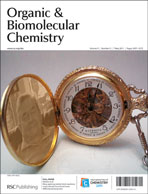Analysis of the products formed in the reaction of NO3˙ with the N- and C-protected aromatic amino acids 1–5, which was performed under conditions that simulate exposure of biosurfaces to environmental pollutants, revealed insight how this important atmospheric free-radical oxidant can cause irreversible damage. In general, NO3˙ induced electron transfer at the aromatic ring is the exclusive initial pathway in a multi-step sequence, which ultimately leads to nitroaromatic compounds. In the reaction of NO3˙ with tryptophan 5 tricyclic products 12 and 13 are formed through an intramolecular, oxidative cyclization involving the amide moiety. In addition to this, strong indication for formation of N-nitrosamides was obtained, which likely result from reaction with N2O4 through an independent non-radical pathway.
You have access to this article
 Please wait while we load your content...
Something went wrong. Try again?
Please wait while we load your content...
Something went wrong. Try again?


 Please wait while we load your content...
Please wait while we load your content...